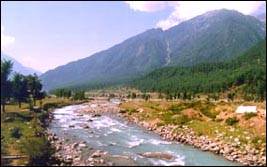| Destinations
|
|||||
Sericulture is practiced here and Kashmiri silk has long been
popular A pastoral economy, sheep and goat farming, as well as
cattle breeding and yak rearing have been practiced for ages.
The Kashmir goat, provides pashmina, from which special
pashmina shawls are made, for which Kashmir is well known.
Traditionally, Kashmir was always famous for its handicrafts
industries, which included weaving of local silk and wool,
carpet and rug weaving, wood-carving, and papier-mâché.
Precision instruments, metal ware, sporting goods, furniture,
matches, resin and turpentine are the major industrial
products. Tourism was one of the oldest and most successful
industries here. Unfortunately, development has been
suffocated by terrorism, and it is only recently that Kashmir
valley is seeing a trickle of tourists again. This region has
some mineral and fossil-fuel resources, mainly in Jammu.
Small reserves of natural gas are found near Jammu. In
Udhampur district there are bauxite and gypsum deposits. Other
minerals include limestone, coal, zinc, and copper. Sapphires
are found in the Zanskar mountains of Ladakh, alluvial
gold has been found in the Indus River.
|
More on Kashmir • Overview • History • Geography • People • Festivals • Wildlife • Adventure • Tourist Information • Climate Places to Visit • Drass • Gulmarg • Jammu • Pahalgam • Sonamarg • Srinagar • Ladakh • More on Ladakh • Travelogues • Kashmir • Journey to Ladakh |
||||
All the principal towns, including Leh, and a majority of
the villages have been electrified. Hydroelectric and thermal
generating plants provide power for industrial development
based on available local raw materials.
Jammu is the terminus for the Northern Railway of India. Srinagar and Jammu are both connected by air to Delhi as well as to other cities. Leh, the principal town of Ladakh is connected by air to Srinagar as well as to Delhi. The Governemnt of India state invested a great deal in developing a system of roadways and telecommunications here, but transportation to the interior areas continues to be a problem in this rugged mountainous region. There is are two major road links conncecting Leh to Manali in the Kullu Valley of Himachal Pradesh and to Srinagar, the capital of J & K. Compiled by Puneet Sachdeva |
|||||
Editor: Romola Butalia (c) India Travelogue. All rights reserved. |
|||||
 Some of the most productive arable lands in the western
Himalayas are in the Kashmir valley. The majority of the
population pursues subsistence agriculture in the main valleys
on terraced slopes. The chief crops are rice, maize, wheat,
barley, pulses, oilseeds and tobacco. Kashmir valley is famous
for its large orchards producing apples, pears, peaches,
mulberries, walnuts and almonds. This area is also the sole
producer of saffron in the Indian subcontinent. Kashmir, with
its forest cover is well known for its timber products.
Some of the most productive arable lands in the western
Himalayas are in the Kashmir valley. The majority of the
population pursues subsistence agriculture in the main valleys
on terraced slopes. The chief crops are rice, maize, wheat,
barley, pulses, oilseeds and tobacco. Kashmir valley is famous
for its large orchards producing apples, pears, peaches,
mulberries, walnuts and almonds. This area is also the sole
producer of saffron in the Indian subcontinent. Kashmir, with
its forest cover is well known for its timber products.